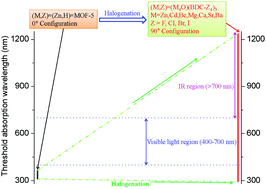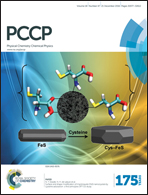Halogenated MOF-5 variants show new configuration, tunable band gaps and enhanced optical response in the visible and near infrared†‡
Abstract
Inspired by recent experimental fabrication of mono-halogenated versions of Metal–Organic Framework MOF-5 (i.e., X-MOF-5, X = F to I) and some experimentally known fully halogenated MOF compounds, we systematically studied frameworks incorporating full halogenation of the BDC linkers of the prototypical Iso-Reticular Metal–Organic Framework (IRMOF) series, exemplified by MOF-5. Using quantum chemistry calculations, we find that halogenation leads to a 90° rotation of the aryl group, which is mainly ascribed to overcrowding between halogen atoms and the carboxyl and benzene ring and strong repulsion among in-plane atoms/groups. The 90° configuration decreases the repulsion, and maximizes the stabilization energy, and is therefore more stable than 0° configuration. We find that the band gap can be tuned from 4.1 to 1.5 eV as we go from F, Cl, Br, to I. This extends the optical response of these experimentally accessible materials through the visible and infrared region. We have also considered a broader range of new materials that substitute various metals for Zn. Totally, 70 materials were systematically examined computationally including (M4O)(BDC-Z4)3 (M = Zn, Cd, Be, Mg, Ca, Sr, Ba; Z = H, F, Cl, Br, I). For the full range of materials, we calculate band gaps of 4.2 to 1.0 eV, corresponding to a threshold of absorption of 290–1240 nm. Four selected materials were tested for stability using short 5 ps molecular dynamics simulations up to 600 K. The new materials with the smallest band gaps could potentially be used in near-infrared (NIR) light-emitting devices. Other properties, e.g., bulk moduli, formation energy, chemical bonding, and optical properties, were also investigated. The present results may provide new materials for use as novel photocatalysts, photoactive materials for photovoltaic cells, or functional devices in nanoelectronics and optoelectronics.



 Please wait while we load your content...
Please wait while we load your content...